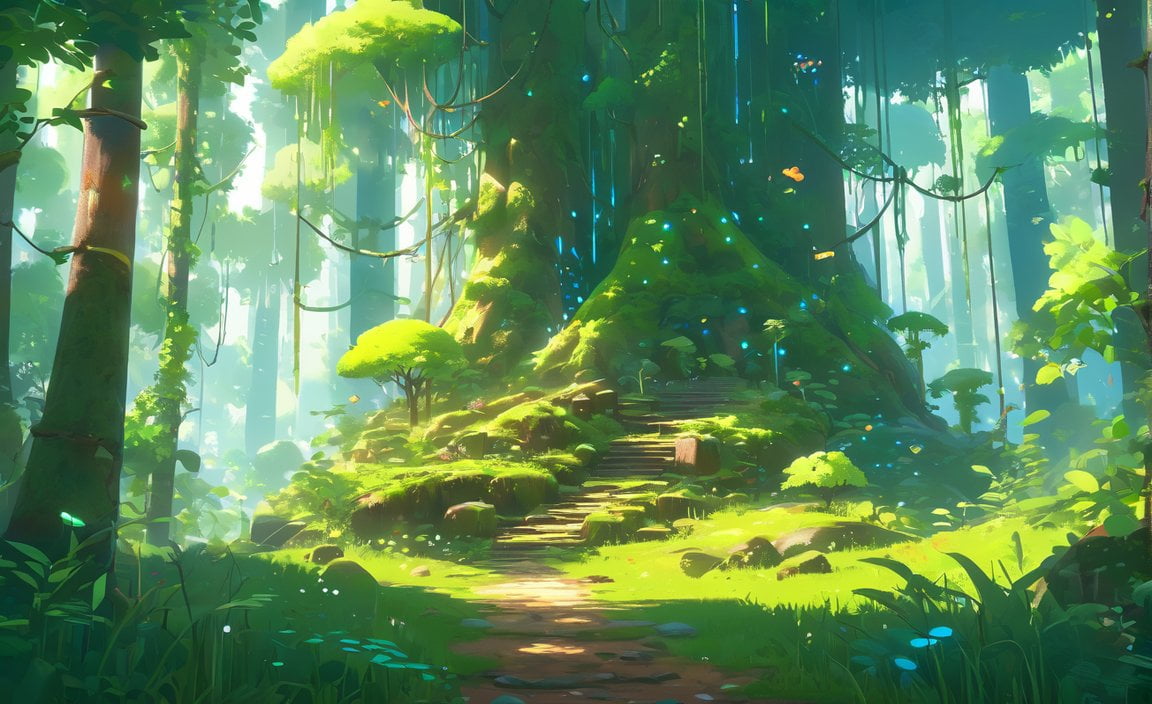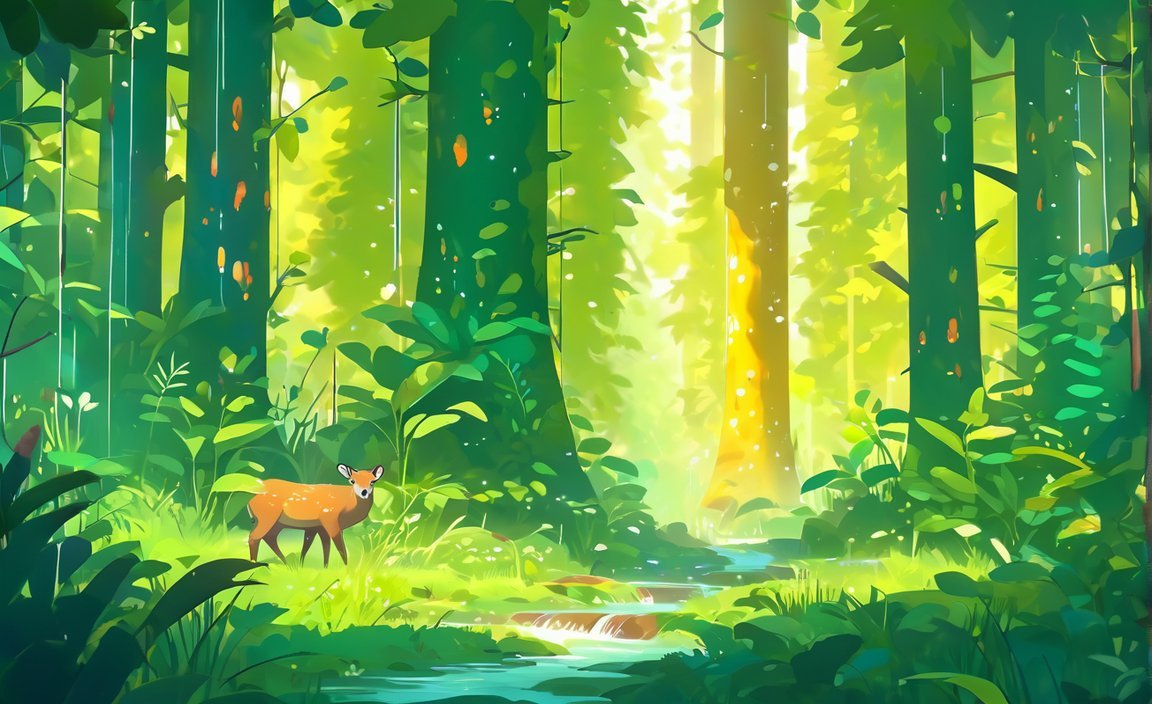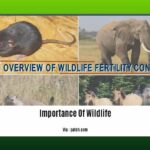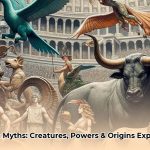The delicate balance of the forest food chain ecosystem is a captivating topic that unveils the intricate dynamics and interconnectedness of plants, herbivores, predators, and decomposers within forest habitats. As an experienced wildlife biologist specialized in forest ecosystems, I bring a wealth of knowledge and expertise in understanding the delicate interplay between species interactions and ecological processes. Join me on a journey to explore the fascinating world of the forest food chain and discover the hidden wonders that sustain life in this enchanting ecosystem.

Key Takeaways:
- The forest food chain consists of producers, primary consumers, secondary consumers, and tertiary consumers.
- Producers create the initial energy source in the ecosystem, typically using sunlight.
- Primary consumers are herbivores that consume the producers.
- Secondary consumers are carnivores that primarily eat primary consumers.
- Tertiary consumers are the top predators at the top of the food chain.
- The forest food chain is a practical tool for understanding energy flow and the impact of species loss or gain in the ecosystem.
- The rainforest food chain is a multi-layered and intricate web.
- The forest ecosystem is arranged from bottom to top, with producers occupying the lowest trophic level and tertiary consumers at the top.
- The forest food chain and web ensure resilience and stability in the ecosystem.
- Biomass determines the size and strength of food chains within a food web.
- Multiple food chains intersect and overlap in the rainforest food web.
- The forest food chain consists of three types: grazing food chain, detritus food chain, and parasitic food chain.
- Food chains model energy exchange in a forest ecosystem.
- Every living thing in an ecosystem is part of multiple food chains.
- Forest food systems contribute to food security and enhance forest-agriculture linkages.
- A food chain is a linear sequence of organisms through which nutrients and energy pass as one organism eats another.
- Each food chain in the forest is one possible path for energy and nutrients.
- The forest food chain describes who eats whom and is crucial for the survival of every living thing in the ecosystem.
Forest Food Chain Ecosystem
The forest food chain ecosystem is a fascinating web of life, where every organism plays a crucial role in maintaining the delicate balance of nature. From towering trees to tiny decomposers, each component interacts with one another, passing energy and nutrients from one level to the next.
Understanding the Forest Food Chain
At the foundation of the forest food chain are the producers, which harness the energy from sunlight to create organic matter through photosynthesis. These producers, such as plants and trees, form the basis of the entire ecosystem by converting sunlight into usable energy.
Moving up the chain, we have the primary consumers, also known as herbivores. These animals feed on the producers, extracting energy and nutrients from plant matter. Think of deer grazing on leaves or rabbits munching on grass.
Next, we have the secondary consumers, which are carnivores that primarily feed on the primary consumers. These predators maintain the balance by controlling the population of herbivores. Picture wolves preying on deer or birds swooping down to catch rabbits.
At the top of the forest food chain are the tertiary consumers, the ultimate predators. These formidable creatures have few natural enemies and regulate the populations of lower-level consumers. In a forest, this could be a majestic predator like a cougar or a fierce bird of prey.
Interconnectedness and Complexity
The forest food chain ecosystem is not simply a linear progression; it is a complex network of interconnected food chains. In the rainforest, especially, the food web is multi-layered and intricate, involving countless organisms and interactions. From the top predator to the smallest decomposer, they all have important roles to play.
Multiple food chains intersect and overlap within the rainforest food web, creating a dynamic system that ensures resilience and stability. Each species within these chains relies on others for survival, making the forest food chain ecosystem a remarkable example of interdependence.
The Importance of Balance
Maintaining a balanced forest food chain is vital for the survival and health of the entire ecosystem. Disruptions to the delicate equilibrium can have far-reaching consequences. For example, if the population of predators diminishes, herbivores may multiply unchecked, leading to overgrazing and the depletion of plant resources. In turn, this can impact the availability of food and habitat for other species, causing a ripple effect throughout the ecosystem.
Biomass, or the amount of living material within a food chain, also plays a significant role in determining the size and strength of these chains within the forest food web. A diverse and robust food web with ample biomass can better withstand disturbances and ensure the continuation of life.
Preserving the Forest Food Chain Ecosystem
Understanding the intricacies of the forest food chain ecosystem is crucial for its conservation. Recognizing the interconnectedness of species and the role they play in energy flow can guide efforts to protect and restore these fragile habitats.
Conservation measures may include preserving large tracts of forest, promoting sustainable logging practices, and creating protected areas for endangered species. By safeguarding the forest food chain ecosystem, we not only preserve the biodiversity of these incredible habitats but also maintain their contributions to food security and enhance forest-agriculture linkages.
In conclusion, the forest food chain ecosystem is a testament to the wonder and complexity of nature. From producers to predators, each organism has its place and purpose within this intricate web of life. By understanding and respecting the delicate balance of the forest food chain ecosystem, we can ensure the longevity and vitality of these essential habitats.
Check out these fascinating facts about a violin at ../facts-about-a-violin!
Curious to know if carbon is malleable? Find out more at ../is-carbon-malleable!
Explore the food chain of a great white shark and discover its role in the ocean ecosystem at ../food-chain-of-a-great-white-shark!
Challenge your knowledge with a marine mammals word search at ../marine-mammals-word-search and see how many you can find!
Embark on a celestial adventure and search for visible stars in this word search at ../visible-stars-word-search!
Ever wondered how long dart frogs live? Uncover the answer at ../how-long-do-dart-frogs-live!
Discover the abiotic factors of the boreal forest and their impact on the ecosystem at ../boreal-forest-abiotic-factors!
Unveil the intricate food chain of a lion and its role in the wild at ../the-food-chain-of-a-lion!
Want to learn how gemstones work scientifically? Dive into the fascinating details at ../how-do-gemstones-work-scientifically!
Test your knowledge of waves by labeling their different parts at ../label-the-parts-of-the-wave!
Explore the atom model of sodium and unravel its unique characteristics at ../atom-model-of-sodium!
Immerse yourself in the mesmerizing world of birds of the savanna at ../birds-of-the-savanna!
Discover the differences between male and female cardinals, two colorful bird species, at ../difference-between-male-and-female-cardinals!
Have you ever wondered what a penguin’s mouth looks like? Find out now at ../what-does-a-penguin-s-mouth-look-like!
Dynamics and Interactions within the Forest Food Chain Ecosystem
In the world of the forest food chain ecosystem, a delicate balance exists between the various organisms that inhabit this complex web of life. From producers to predators, each link in the chain plays a crucial role in maintaining the overall health and stability of the ecosystem. In this article, we will explore the dynamics and interactions that make this intricate system thrive.
Linking the Web: Food Chains and Webs
When we think of a food chain, we often imagine a linear progression from plants to herbivores to predators. While this is certainly one aspect of the forest food chain, it is important to recognize that ecosystems are much more intricate than a simple chain. Instead, they are composed of complex food webs, where prey and predators interact with one another within a larger network of species.
Within these webs, different predator species can have a significant impact on the interactions of the entire community. Their presence or absence can influence the dynamics of the web, as well as the abundance of other species. By understanding these interconnections, we gain insight into the delicate balance that exists within the forest food chain ecosystem.
Herbivores and Plants: A Delicate Dance
The relationship between plants and herbivores is another vital aspect of the forest food chain ecosystem. Insects, for example, can have diverse impacts on plant communities depending on their taxonomy and ecological diversity. By studying these interactions, we begin to unravel the intricate dance between insects and their plant counterparts.
Horizontal interactions also contribute to the dynamics of the food chain. Competition, facilitation, and mutualism among individuals feeding at the same trophic level, such as insect herbivores, shape the overall ecosystem. These interactions are essential in understanding how different species coexist within the forest food chain.
The Predator-Prey Dance
Predation, the consumption of one organism by another, is a powerful force within the forest food chain ecosystem. Predators act as regulators of population sizes, ensuring the health and balance of the ecosystem. By controlling herbivore populations, predators play a crucial role in maintaining the delicate dance between prey and plants.
Additionally, host-parasite interactions also have significant implications for the dynamics of the food chain. Parasites, organisms that obtain nutrition from their host and cause harm or damage, can influence the overall structure and function of the entire ecosystem. Recognizing the complexities of these interactions is vital in understanding the dynamics within the forest food chain.
The Factors at Play
A multitude of factors, including taxonomy, morphology, physiology, environment, food availability, and interacting species, shape the dynamics and interactions within the forest food chain ecosystem. By studying these factors, we gain a deeper understanding of the complex web of life that exists within the forest.
Maintaining a Balanced Forest Food Chain Ecosystem
Taking care to maintain the delicate balance of the forest food chain is crucial for the survival and health of the ecosystem. Disruptions to this balance can have far-reaching consequences, such as overgrazing and depletion of resources. By promoting conservation efforts and sustainable practices, we can protect and restore the forest food chain ecosystem for generations to come.
Key Takeaways:
- The forest food chain consists of complex food webs where prey and predators interact within a larger network of species.
- Interactions among different predator species can have a significant impact on the entire community.
- Herbivore interactions with plants contribute to the dynamics of the food chain ecosystem.
- Horizontal interactions, such as competition and mutualism, shape the overall ecosystem.
- Predators play a vital role in regulating the populations of lower-level consumers.
- Host-parasite interactions influence the structure and dynamics of the food chain ecosystem.
- Factors such as taxonomy, morphology, and environment shape the food chain within the forest.
- Maintaining a balanced forest food chain is essential for the survival and health of the ecosystem.
- Conservation efforts and sustainable practices are crucial for protecting and restoring the forest food chain ecosystem.
Sources:
1. Food Chains and Webs: Interaction with Ecosystem
2. Food chains and webs – Ecosystems and habitats – KS3 Biology – BBC
Energy flow through the forest food chain ecosystem
In the complex and interconnected world of the forest food chain ecosystem, energy flows in a delicate balance. Understanding this energy flow is essential for comprehending the dynamics of the ecosystem and the interactions between its various organisms. Let’s explore the key elements of energy flow through the forest food chain ecosystem and discover why it is crucial for its stability and survival.
Producers: The Foundation of Energy
At the base of the forest food chain ecosystem are the producers, primarily plants and trees. These remarkable organisms harness the power of sunlight through photosynthesis, or in some cases, chemosynthesis, to create organic matter. They use this energy to fuel their growth and survival. Regularly replenishing the energy in the system, producers are the foundation on which the entire food chain rests.
Primary Consumers: Herbivores Nourished by Producers
Closely connected to the producers are the primary consumers, also known as herbivores. Herbivores rely on the primary producers as their source of energy and nutrients. They feed on plant matter, extracting the energy-rich compounds and using them to sustain their own growth and reproduction. Through this feeding process, the energy captured by the producers is transferred to the primary consumers.
Secondary Consumers: Controlling Herbivore Populations
The forest food chain ecosystem goes a step further with the presence of secondary consumers, which are carnivores that primarily feed on the primary consumers. By controlling the populations of herbivores, they help to maintain a balance within the ecosystem. Through predation, energy flows from the primary consumers to the secondary consumers, driving the intricate dynamics of the food chain.
Decomposers: The Recyclers of Energy and Nutrients
In this intricate web of life, decomposers play a vital role in the forest food chain ecosystem. Their primary job is to break down dead organisms and organic matter, recycling the energy and nutrients back into the environment. By doing so, they ensure that the energy and resources captured by the producers are not lost but instead reused and redistributed throughout the ecosystem.
Energy Transfer Efficiency: The Limiting Factor
The efficiency of energy transfer limits the length of food chains within the forest food chain ecosystem. Each step in the food chain results in some energy loss, mainly through waste production and metabolic processes. This energy loss restricts the number of trophic levels and the length of the food chain. As a result, the energy flow through the forest food chain ecosystem follows a pyramid-like structure, with each level supporting fewer organisms.
Key Takeaways:
- Energy flows through the forest food chain ecosystem, starting with the producers, such as plants and trees, harnessing the energy of the sun through photosynthesis.
- Herbivores, or primary consumers, feed on the producers, transferring energy from plants to animal consumers.
- Secondary consumers, carnivores that feed on herbivores, play a role in controlling herbivore populations.
- Decomposers break down dead organisms and recycle energy and nutrients back into the ecosystem.
- Energy transfer efficiency limits the length of food chains in the forest food chain ecosystem, resulting in a pyramid-like structure.
- Preserving the delicate balance of the forest food chain ecosystem is crucial to its survival and health.
Citation:
– Biology LibreTexts – Energy Flow through Ecosystems
– National Geographic Society – Energy Flow Through an Ecosystem
The Importance of Maintaining a Balanced Forest Food Chain
Key Takeaways:
- A balanced forest food chain is crucial for the thriving of the entire ecosystem, especially in rainforests with high biodiversity.
- Disruptions to the forest food chain can have far-reaching consequences, impacting climate change and the overall balance of the ecosystem.
- Sustainable forest management plays a vital role in ensuring the integrity of the forest food chain.
- Understanding and maintaining the forest food chain is essential for the conservation of species and the overall balance of the ecosystem.
The forest food chain ecosystem is a fascinating and intricate web of interconnected organisms that play crucial roles in maintaining the balance of nature. Within this ecosystem, plants, herbivores, predators, and decomposers engage in a complex dance of energy flow and species interactions.
In this vibrant and diverse system, producers, such as plants and trees, use photosynthesis to harness sunlight and create organic matter. They form the foundation of the food chain, providing energy and nutrients for other organisms. Through their green leaves and vibrant colors, they are the lifeblood of the forest.
Herbivores, as primary consumers, feed on the producers, extracting energy and nutrients from plant matter. These plant-eating animals range from insects to mammals, and they play a crucial role in shaping the forest ecosystem by controlling vegetation growth and dispersing seeds.
On the next level of the food chain, we find carnivores as secondary consumers. These animals primarily feed on herbivores, helping to regulate their populations and control the balance within the ecosystem. From predatory birds and mammals to reptiles and amphibians, they ensure that the herbivore populations are kept in check and prevent overgrazing.
At the top of the forest food chain are the tertiary consumers, also known as top predators. These mighty creatures, such as big cats or wolves, regulate the populations of lower-level consumers. By controlling the numbers of herbivores and secondary consumers, they maintain a balance that ensures the overall health and survival of the ecosystem.
It is crucial to understand that the forest food chain ecosystem is not linear but rather a network of interconnected food chains. This complexity is particularly evident in rainforests, which boast incredibly high biodiversity and complex interdependencies. Each organism within the food chain has its role, and disturbances to this delicate balance can have significant consequences.
Maintaining a balanced forest food chain is imperative for the survival and health of the ecosystem. Disruptions, such as deforestation, habitat destruction, or the introduction of invasive species, can have far-reaching effects on both wildlife and the environment. The consequences of these disruptions can include overgrazing, depletion of resources, and even climate change.
The importance of sustainable forest management cannot be overstated. By employing sustainable practices, we can ensure the integrity of the forest food chain. This includes preserving forests, protecting key habitats, and promoting responsible land use. By doing so, we safeguard the delicate balance of the ecosystem, ensuring the continued existence of numerous species and the overall health of the environment.
In conclusion, the forest food chain ecosystem is a dynamic and intricate system of interactions between plants, herbivores, predators, and decomposers. Understanding and maintaining this delicate balance is crucial for the conservation of species and the overall balance of the ecosystem. The importance of maintaining a balanced forest food chain cannot be overstated, as it plays a vital role in ensuring the thriving of the entire ecosystem and safeguarding the environment for future generations.
Key Takeaways:
- A balanced forest food chain is crucial for the thriving of the entire ecosystem, especially in rainforests with high biodiversity.
- Disruptions to the forest food chain can have far-reaching consequences, impacting climate change and the overall balance of the ecosystem.
- Sustainable forest management plays a vital role in ensuring the integrity of the forest food chain.
- Understanding and maintaining the forest food chain is essential for the conservation of species and the overall balance of the ecosystem.
Sources:
- Exploring the Vital Role of Rainforest Food Chain in Ecosystems
- Food Chain: Definition, Types, Importance & Examples

FAQ
Q1: What is a forest food chain ecosystem?
A1: A forest food chain ecosystem refers to the interconnected network of organisms within a forest habitat, where energy and nutrients are transferred from one organism to another through a linear sequence of eating and being eaten.
Q2: What are the different components of a forest food chain ecosystem?
A2: The components of a forest food chain ecosystem include producers (plants), primary consumers (herbivores), secondary consumers (carnivores), and tertiary consumers (top predators). Decomposers also play a critical role in breaking down dead organisms and recycling nutrients.
Q3: How does the forest food chain ecosystem contribute to the balance of life in the rainforest?
A3: The forest food chain ecosystem helps maintain the balance of life in the rainforest by regulating population sizes, distributing energy and nutrients, and ensuring the resilience and stability of the ecosystem. Each organism has a specific role within the food chain, and any disruption can have cascading effects on other organisms.
Q4: What are the different types of food chains within a forest food chain ecosystem?
A4: The forest food chain ecosystem consists of various types of food chains, including the grazing food chain (plants to herbivores), detritus food chain (dead organic matter to decomposers), and parasitic food chain (parasites to hosts). These food chains intersect and overlap to form a complex food web.
Q5: How does the forest food chain ecosystem support food security and enhance forest-agriculture linkages?
A5: The forest food chain ecosystem contributes to food security by providing resources and habitat for organisms that are important for agriculture, such as pollinators and natural pest control agents. Maintaining a healthy forest food chain ecosystem is crucial for sustainable agriculture practices and ensuring a stable food supply.
- Unlock Ancient Roman Jewelry’s Secrets: History, Materials, & Symbolism Revealed - August 14, 2025
- Unveiling Ancient Roman Mythical Creatures: Legends, Powers & Origins Defined for Today’s Enthusiast - August 14, 2025
- Unlock Ancient Secrets: Ancient Roman Attire Women, Status, & Materials [Guide] - August 14, 2025
















